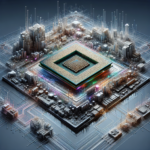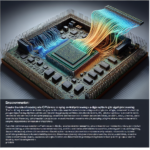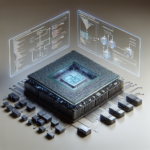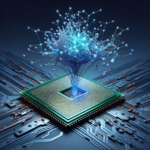Understanding CPU Microarchitecture and Its Impact on Performance

Understanding CPU Microarchitecture and Its Impact on Performance
Central Processing Units (CPUs) are the heart of modern computing devices, driving everything from personal computers to servers and mobile devices. The performance of a CPU is not solely determined by its clock speed or the number of cores it has; the underlying microarchitecture plays a crucial role. This article delves into the intricacies of CPU microarchitecture and explores how it impacts overall performance.
What is CPU Microarchitecture?
CPU microarchitecture refers to the design and organization of the various components within a CPU. It encompasses the layout of the execution units, cache hierarchy, pipeline stages, and other critical elements that determine how efficiently a CPU can execute instructions. While the instruction set architecture (ISA) defines the set of instructions a CPU can execute, the microarchitecture dictates how these instructions are implemented and processed.
Key Components of CPU Microarchitecture
To understand CPU microarchitecture, it is essential to familiarize oneself with its key components:
- Execution Units: These are the parts of the CPU that perform arithmetic and logical operations. They include Arithmetic Logic Units (ALUs), Floating Point Units (FPUs), and other specialized units.
- Pipeline: The pipeline is a series of stages through which instructions pass. Each stage performs a part of the instruction, allowing multiple instructions to be processed simultaneously.
- Cache Hierarchy: Caches are small, fast memory units located close to the CPU cores. They store frequently accessed data to reduce latency. The hierarchy typically includes L1, L2, and L3 caches.
- Branch Predictors: These components predict the direction of branch instructions to minimize pipeline stalls and improve instruction flow.
- Out-of-Order Execution: This technique allows the CPU to execute instructions out of their original order to optimize resource utilization and reduce idle time.
- Instruction Decoders: These units translate complex instructions into simpler micro-operations that the CPU can execute more efficiently.
How CPU Microarchitecture Impacts Performance
The design choices made in CPU microarchitecture have a profound impact on performance. Here are some key factors:
Instruction-Level Parallelism (ILP)
ILP refers to the ability of a CPU to execute multiple instructions simultaneously. Modern CPUs achieve ILP through techniques like pipelining, out-of-order execution, and superscalar architecture. By increasing ILP, CPUs can process more instructions per clock cycle, leading to higher performance.
Cache Efficiency
The efficiency of the cache hierarchy significantly affects performance. A well-designed cache system reduces the time it takes for the CPU to access data, minimizing latency and improving throughput. Cache size, associativity, and replacement policies are critical factors in cache efficiency.
Branch Prediction Accuracy
Branch predictors play a vital role in maintaining a smooth instruction flow. Accurate branch prediction reduces pipeline stalls and ensures that the CPU can continue executing instructions without waiting for branch resolution. Modern CPUs use advanced branch prediction algorithms to achieve high accuracy.
Pipeline Depth and Width
The depth and width of the pipeline influence how many instructions can be processed simultaneously. A deeper pipeline allows for higher clock speeds but may increase latency due to longer instruction paths. A wider pipeline can execute more instructions per cycle but requires more resources and power.
Out-of-Order Execution
Out-of-order execution allows the CPU to utilize idle execution units by reordering instructions. This technique improves resource utilization and reduces bottlenecks, leading to better performance. However, it also adds complexity to the microarchitecture.
Evolution of CPU Microarchitecture
CPU microarchitecture has evolved significantly over the years, driven by the need for higher performance and efficiency. Here are some notable milestones:
Early Microarchitectures
Early CPUs, such as the Intel 4004 and 8086, had simple microarchitectures with limited ILP and no cache hierarchy. These CPUs relied on increasing clock speeds to improve performance.
Introduction of Pipelining
The introduction of pipelining in CPUs like the Intel 80486 and the Motorola 68040 marked a significant advancement. Pipelining allowed for overlapping instruction execution, increasing ILP and performance.
Superscalar Architecture
Superscalar CPUs, such as the Intel Pentium and the AMD K5, introduced multiple execution units, enabling the parallel execution of instructions. This architecture significantly boosted performance by increasing ILP.
Out-of-Order Execution and Branch Prediction
Modern CPUs, starting with the Intel Pentium Pro and the AMD Athlon, incorporated out-of-order execution and advanced branch prediction techniques. These innovations improved resource utilization and reduced pipeline stalls.
Multi-Core and Heterogeneous Architectures
The shift to multi-core CPUs, exemplified by the Intel Core and AMD Ryzen series, allowed for parallel processing of multiple threads. Heterogeneous architectures, such as ARM’s big.LITTLE, combine high-performance and power-efficient cores to optimize performance and energy consumption.
Impact of CPU Microarchitecture on Different Applications
The impact of CPU microarchitecture varies depending on the type of application. Here are some examples:
Gaming
Gaming applications benefit from high ILP, efficient cache systems, and advanced branch prediction. Modern games often rely on complex physics simulations and AI algorithms, which require robust CPU performance.
Scientific Computing
Scientific computing applications, such as simulations and data analysis, benefit from high floating-point performance and efficient memory access. CPUs with powerful FPUs and large caches are well-suited for these tasks.
Data Centers and Servers
Data centers and servers require CPUs with high throughput and energy efficiency. Multi-core and multi-threaded architectures are essential for handling concurrent workloads and maximizing resource utilization.
Mobile Devices
Mobile devices prioritize power efficiency and thermal management. Heterogeneous architectures, such as ARM’s big.LITTLE, balance performance and energy consumption to extend battery life while delivering adequate performance for everyday tasks.
Future Trends in CPU Microarchitecture
The future of CPU microarchitecture is shaped by emerging technologies and evolving demands. Here are some trends to watch:
AI and Machine Learning
AI and machine learning workloads are becoming increasingly important. Future CPUs will likely incorporate specialized accelerators and optimized microarchitectures to handle these tasks more efficiently.
Quantum Computing
While still in its infancy, quantum computing has the potential to revolutionize computing. Future CPUs may integrate quantum co-processors to tackle specific problems that are currently infeasible for classical computers.
Energy Efficiency
As energy consumption becomes a critical concern, future CPUs will focus on improving energy efficiency. Techniques like dynamic voltage and frequency scaling (DVFS) and advanced power management will play a significant role.
3D Stacking and Chiplets
3D stacking and chiplet-based designs offer new ways to improve performance and scalability. These approaches allow for more efficient use of silicon real estate and better integration of heterogeneous components.
FAQ
What is the difference between CPU architecture and microarchitecture?
CPU architecture refers to the overall design and structure of a CPU, including its instruction set architecture (ISA), which defines the set of instructions the CPU can execute. Microarchitecture, on the other hand, focuses on the internal design and organization of the CPU’s components, such as execution units, pipelines, and caches, to implement the ISA efficiently.
How does cache size impact CPU performance?
Cache size significantly impacts CPU performance by reducing the time it takes to access frequently used data. Larger caches can store more data, reducing the need to fetch data from slower main memory. This leads to lower latency and higher throughput, especially for applications with high memory access patterns.
What is the role of branch prediction in CPU performance?
Branch prediction is crucial for maintaining a smooth instruction flow in the CPU pipeline. Accurate branch prediction minimizes pipeline stalls caused by branch instructions, allowing the CPU to continue executing instructions without waiting for branch resolution. This improves overall performance by reducing idle time and increasing instruction throughput.
Why is out-of-order execution important?
Out-of-order execution allows the CPU to execute instructions out of their original order to optimize resource utilization and reduce bottlenecks. This technique improves performance by ensuring that execution units are not idle and that instructions are processed as efficiently as possible, even if they arrive out of order.
How do multi-core CPUs improve performance?
Multi-core CPUs improve performance by allowing multiple threads to be processed simultaneously. Each core can handle its own set of instructions, enabling parallel processing and better resource utilization. This is particularly beneficial for multi-threaded applications and workloads that can be divided into smaller tasks.
Conclusion
Understanding CPU microarchitecture is essential for appreciating the complexities of modern computing. The design choices made in microarchitecture have a profound impact on performance, influencing everything from gaming and scientific computing to data centers and mobile devices. As technology continues to evolve, future CPUs will incorporate new innovations to meet the growing demands of various applications. By staying informed about these developments, we can better understand the capabilities and limitations of the CPUs that power our digital world.




